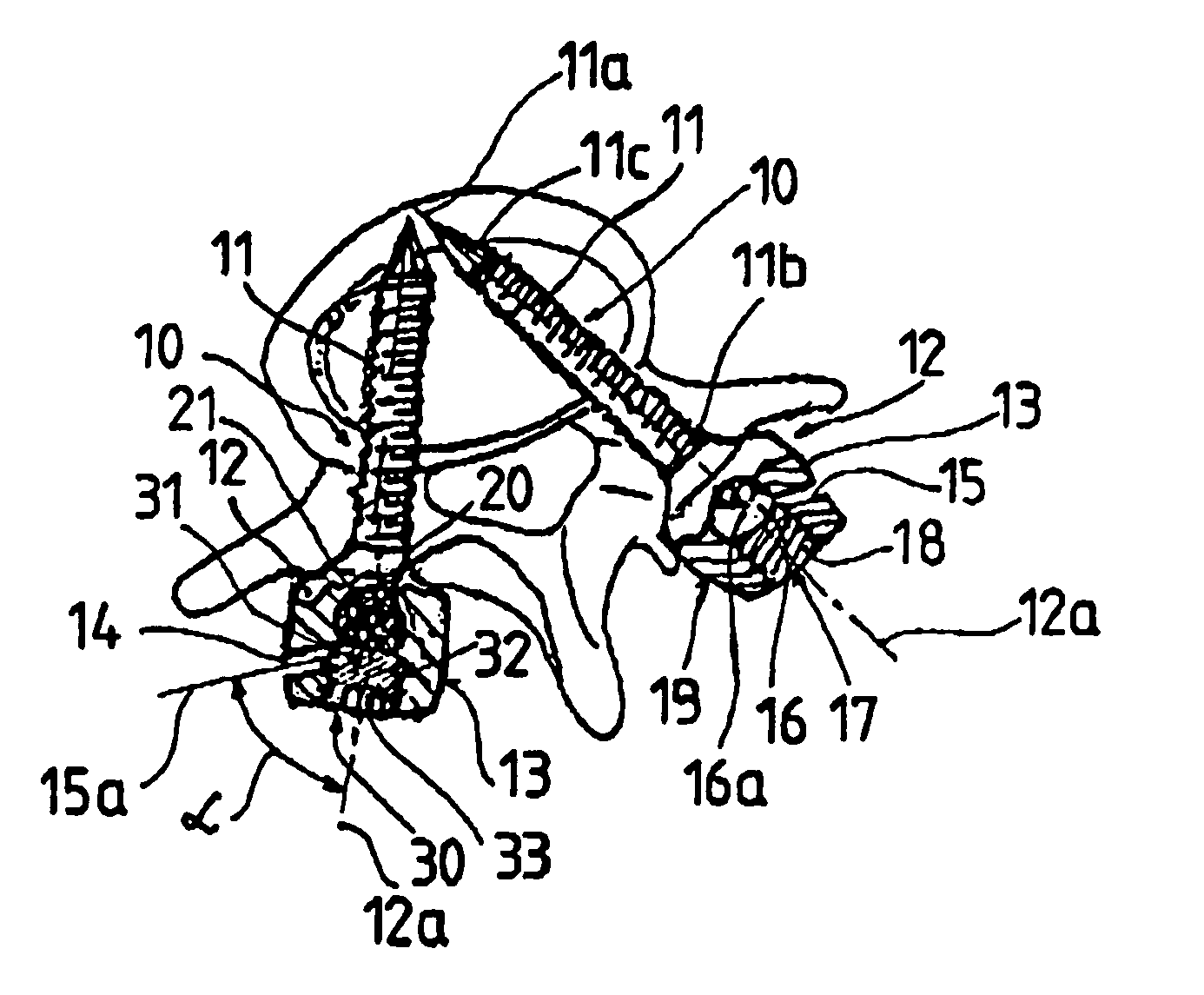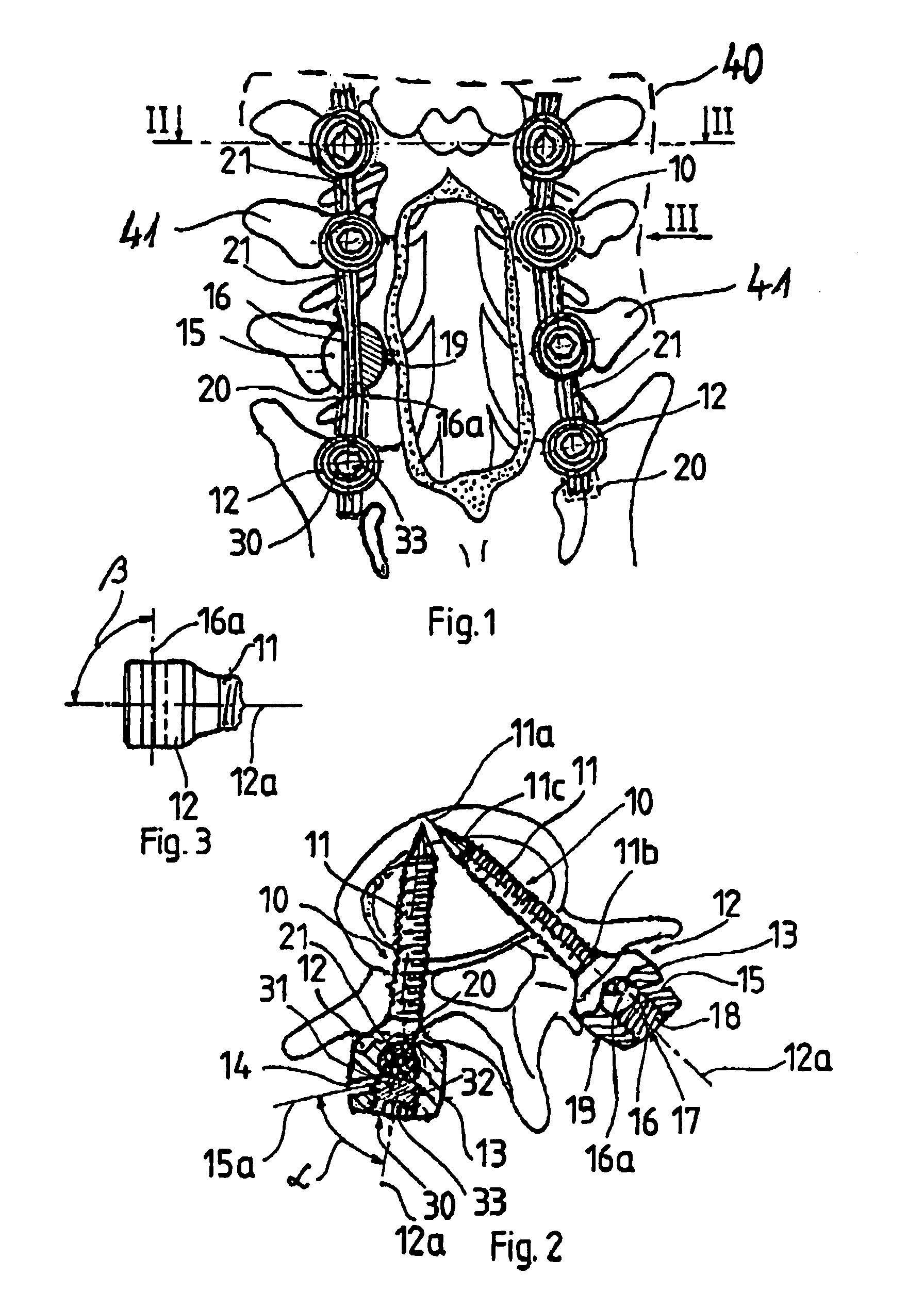The
disadvantage of the known solutions, however, is that the longitudinal sizes of the usual supporting elements and the fixating devices are complex and, due to the structure that results in significant dimensions, the operation is more difficult and the “hiding” of the built-in structural elements cannot be solved in every case.
Another
disadvantage is that, with the traditional assemblies, where the elements are rigid, when the patient moves, the supporting elements may become deformed or, in extreme cases, broken at which time the fixation of the
vertebra is terminated.
The restoration of the desired condition may only be solved with a further operation that causes a significant burden for the patient.
A further deficiency of the known versions is that the normally used screw fixating connection device is susceptible to fatigue, and the replacement of the faulty element and the correction of the fixture also require a further surgical intervention.
Another unfavourable aspect is that, in the case of spine implants that bridge over more than two vertebrae, the appropriate planar and spatial connections of the supporting elements and connection bodies cause great difficulty, require a great number of special instruments and auxiliary equipment, and also significantly increase the duration of the operation, which not only increases the burden on the patient, but also unjustifiably increases the possibility of complications during the operation.
A further aspect that has to be treated as a
disadvantage is that, in the case of traditional solutions in different sections of the
spinal column, supporting elements of differing sizes and different instruments have to be used, which makes the fast and efficient performance of the operation even more difficult.
The significant disadvantage of this structure, however, is that the dimensions of the accepting seat, of the cleft leading to it, and of the connection part-unit are essentially equal, and so only a single, thick cross-section, less deformable, rod-like connection unit can be fixed into the head part of the supporting element.
Such a connection
system does not provide a sufficiently flexible connection possibility between the supporting elements.
Another disadvantage is that, due to the geometric dimensions of the head part of the supporting element presented above, the connection part-unit is difficult to
handle and is difficult to fix into the accepting seat of the head part.
Therefore, the connection part-unit has to be fixed into the head part of the supporting element immediately following positioning, which, however, makes the fine setting of the connection part-unit and the positioning of the supporting elements more complicated.
However, a significant disadvantage is that, due to the fixing together of the wires, putting them into the supporting elements and fixing them is complex since, due to the joint movement of the wires here also, the cleft leading into the fixing hollow essentially has to comply with the cross-section size formed by the wires altogether.
As a result of this, this arrangement also does not solve the problem of easy handling and simpler fixing.
The greatest disadvantage of the above solution is that, due to the compulsory use of the six fixing screws and the pre-shaped, bent linking and clamping elemental strands, it can only be used in certain cases and in the case of the linking together of a restricted number of vertebrae.
Therefore, its area of use is significantly limited, and it is not suitable for carrying out general vertebrae fixing tasks.
However, this gives an almost impossible task to the operator due to the unique
bone structure of the individual.
Due to these significant disadvantages, this solution has not become widespread.
Another disadvantage is that all of the pre-bent elemental strands are to be used during the fixing, so that a flexible fix adapting to the patient's form and loading cannot be set up.
A significant disadvantage is that keeping the elemental strands of the connection part-unit in the seating that goes through the head part is difficult due to the outward-facing, wide cleft, which makes the job of the operator significantly more difficult, and which may increase the duration of the operation to a large extent, which is unfavourable from the point of view of the patient.
There is no possibility of such help due to the small area of the operation and the circumstances that present themselves during
surgery, e.g. bleeding and reducing bleeding.
Another disadvantage that can be listed here is that the fixing of the fixing screws is in every case determined by the form and size of the vertebrae, so that, in general, the six fixing screws become positioned at varying heights and angles.
In practice, this cannot be solved.
Another significant disadvantage is that the elements carrying out the cross-linking between the fixing screws result in such rigidity that, in the case of porous vertebrae, this can in some cases lead to the pulling out of the fixing screw.
A further disadvantage of the wide and deep straight cleft forming the seating leading through the head part is that, on the one hand, it increases the dimensions of the head part, which may be a source of further accidents following the operation, and, on the other hand, it reduces the
solidity of the head part, which provides an unjustified restriction on occurring loads.
 Login to View More
Login to View More  Login to View More
Login to View More 

